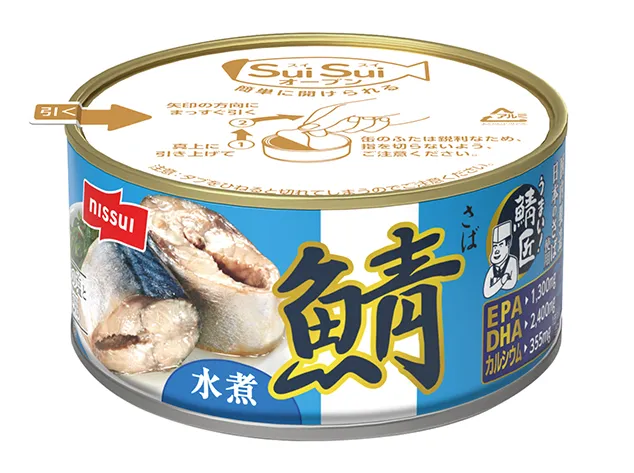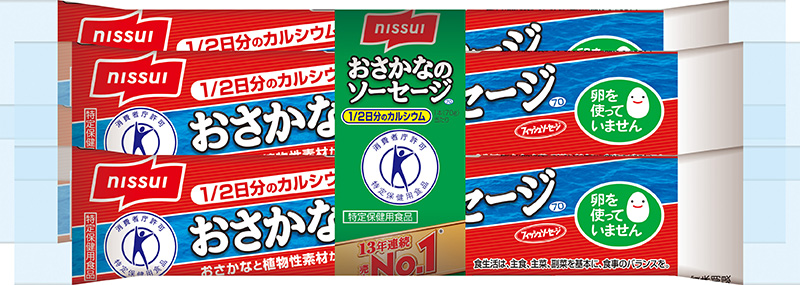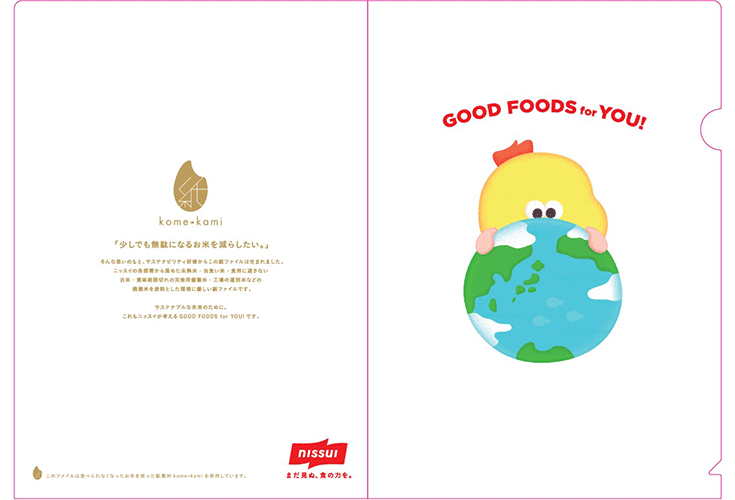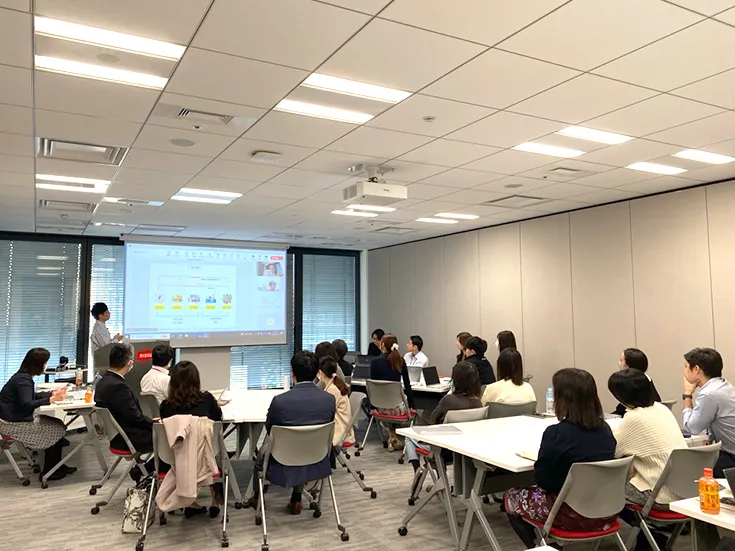Food loss and waste refers to food that can still be eaten but is thrown away. It is said that there are food loss and waste with 1,300 million tons each year globally (Note 1). And while Japan has a low food self-sufficiency rate at around 37% and depends largely on imports for its food (Note 2), more than 6.12 million tons thrown away each year (Note 3). On the other hand, the problem of hunger also continues to exist in the world. There are thought to be about 800 million people without access to adequate nutrition (Note 4).
The Nissui Group, as part of its corporate responsibility of a company handling food, has designated food loss and waste. Mainly through the Food Loss and Waste Subcommittee, we are addressing this issue throughout the supply chain, including raising the awareness of its employees and activities involving the general public, as well as reducing loss in the conventional stages of production, distribution and consumption.
(Note 1): FAO (Food and Agriculture Organization of the United Nations) "Global Food Losses and Food Waste" (2011)
(Note 2): Ministry of Agriculture, Forestry and Fisheries, "FY2018 food supply and demand table (final report) (2020)
(Note 3): Ministry of Agriculture, Forestry and Fisheries, Ministry of the Environment, "FY2017 estimate"
(Note 4): FAO (Food and Agriculture Organization of the United Nations) "The State of Food Security and Nutrition in the World 2019" (2019)
* Food bank: A group which brings together food products with no quality problems but are unsuitable for sale, and people who can’t obtain enough food.
In Japan, the Act on Promoting Food Loss and Waste Reduction (Food Loss and Waste Act) was promulgated in May 2019 (enacted in October 2019). We are making more proactive efforts than ever before to contribute to the SDGs target of halving global food waste by 2030 mentioned in the above Act, as well as to seriously address our obligations as a business operator under the law.
The Food Loss and Waste Subcommittee is engaged in initiatives to reduce food loss and waste in the businesses across the Group companies in Japan and to raise the awareness of the employees.
![[Figure] Promotion Framework](/assets/img/site/140/140_236_img-01e.svg)
The targets specified in the long-term vision, “Good Foods 2030,” and in the mid-term business plan, “Good Foods Recipe1,” are as follows. We set a target for reduction of waste from animal and plant residues (excluding inedible parts of fish, vegetable cores, outer leaves, and similar wastes arising in the production process) and products that can be reduced through self-supporting efforts.
| Indicators | Scope | Results | KPI | ||
|---|---|---|---|---|---|
| FY2022 | FY2023 | Target by 2024 Mid-Term Business Plan "Good Foods Recipe1" |
Target by 2030 Long-Term Vision "Good Foods 2030" |
||
| Waste from animal and plant residues (Compared to FY2017 Unit: Per unit) |
The Nissui Group in Japan | Reduced by 21.1% | Reduced by 21.1% | Reduced by 20% | Reduced by 30% |
| Waste from products (Compared to FY2020 Unit: Absolute quantity) |
Nissui Corporation | Increased by 17.6% | Reduced by 9.3% | - | Reduced by 50% |
Nissui is going forward with initiatives to change the labeling of best-before periods in an effort to reduce food loss and waste. All tinned food products excluding private-brand items manufactured on and after July 1, 2019 are labeled with best-before periods expressed in year/month (labeling format has changed from the conventional year/month/day to year/month.) In this labeling process, storage tests were carried out to check how long quality can be maintained, and it was confirmed that the best-before periods could be extended. As a result of these efforts, we can expect more efficient distribution as well as the reduction of food loss and waste on the entire supply chain.
In addition, for "Osakana no sausage" and "Komiyaki (surimi-based products)" and shelf-stable foods, the best-before period has been extended as indicated in the table below for products for which sensory tests and scientific analysis have confirmed that there is no impact on quality. The Nissui Group has also made efforts to significantly extend the best-before periods of other products including frozen prepared foods for retail and commercial uses.


| Product Name | Production Switching Date | Best-before Periods | Number of Days of Extension | |
|---|---|---|---|---|
| Before | After | |||
| Osakana sausage | February 15, 2021 | 120days | 150days | 30days |
| Komiyaki (surimi-based products) | February 7, 2022 | 45days | 60days | 15days |
| Bottled products (produced by the Group companies) | February 2022 | 12months/18months | 18months/24months | 6months |
| Retort pouch products (soup varieties) | April 2022 | 18months | 24months | 6months |
Since fiscal 2008, Nissui has been donating frozen food to Second Harvest Japan, an NPO that provides food to people in need. Second Harvest Japan plays the role of a food bank for people who cannot get enough food, providing them with foods that have no quality problems but cannot be sold due to being sub selling standards. Going forward, Nissui will continue these activities that lead to providing support to orphanages and mother and child living support facilities, while at the same time reducing the discarding of still-edible food.
| FY2019 | FY2020 | FY2021 | FY2022 | FY2023 | |
|---|---|---|---|---|---|
| Actual donations (t) |
7.9 | 9.0 | 7.7 | 7.9 | 6.0 |

| Donation destination | Donor | Donation details | Volume(kg) |
|---|---|---|---|
| Save the Children Japan | Consumer Products Department |
|
846 |
| Meals on Wheels Japan | Business Development Department, Legal Department, Anjo Plant |
|
3,400 |
| Food bank Yamagata central | Mogamifoods Co., Ltd. |
|
160 |
In conjunction with the participation of AEON Co., Ltd. in the "10x20x30" Food Loss and Waste Initiative advocated by the World Resources Institute (WRI) in December 2019, Nissui joined the "Japan project" led by AEON as one of the partner corporations. In this project, the specifics of the initiatives will be determined in consideration of the company's issues by using examples of spearheading initiatives outside of Japan and other cases as reference, based on the "Target-Measure-Act" approach to initiatives put forth by WRI. Through such initiative, Nissui will further promote the reduction of food loss and waste in the supply chain as a whole.
Participation in External Initiatives
Flatfish Ltd. (UK), which is one of the Nissui Group companies outside of Japan, pledged our support to WRAP (the Waste and Resources Action Programme) in 2021. WRAP is an initiative founded in the UK in 2000 which provides tools and guidance for reducing food waste as one of its efforts. Flatfish started measuring food waste in 2021 and has set a goal of reducing it by 50% by 2030.
In October 2022, Nissui developed a canning process to make effective use of the tail meat generated when it processed Kurose buri (yellowtail), which is procured from Kurose Suisan Co., Ltd., a Nissui Group company. We began selling the canned product in limited regions. In a typical year, about 30 t of tail meat are generated when the buri catch is brought in and processed into fillets and loins. Previously this tail meat was used as feed, but thanks to the newly developed canning process, the tail meat has become a valuable material, contributing to the reduction of food loss and waste.
![[Photo] Canned product: Buri and Daikon, prepared using the tail meat of Kurose buri](/assets/img/site/140/140_428_img-01.jpg)
Canned product: Buri and Daikon, prepared using the tail meat of Kurose buri
To raise employee awareness of reducing food loss and waste, the following two initiatives were implemented as part of the fiscal 2023 training for Sustainability Promotion Members.
Dissemination of Sustainability Activities Throughout Nissui
In an effort to reduce rice waste, rice deemed unfit for consumption—such as immature rice, insect-damaged rice, aged rice not fit for eating, expired emergency reserve rice, and rice discarded during the factory sorting process—was collected from various departments within Nissui and used as raw material to create paper files. These files were then distributed to employees, including those at Group companies, with the intent to emphasize the importance of minimizing waste.

Paper file
In December 2023, a lecture on food loss, a topic of significant interest to the Sustainability Promotion Members, was given by experts in the field. The lecture provided information, new perspectives, and knowledge on food loss, and was followed by group discussions in which participants received feedback from the speakers and explored potential solutions. Many opinions were shared in response to the question posed by the speakers of “How can food loss be turned into ‘beneficial waste’?"

Lecture by external speaker